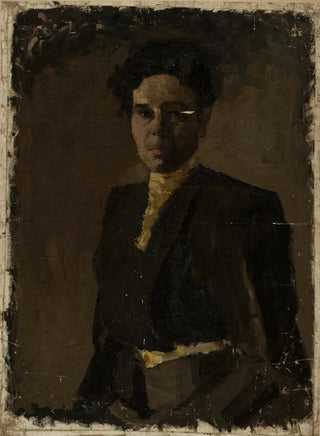Art print | A woman in a dark dress - Nikolai Triik


View from behind

Frame (optional)
The artwork "A Woman in a Dark Dress" by Nikolai Triik is a masterpiece that embodies the beauty and depth of early 20th-century art. Framing a moment of life, this painting evokes an intimate atmosphere, where every detail seems charged with emotion. The female figure, at the center of the composition, draws the eye with her elegant posture and dark dress, which contrasts with the luminous environment. Triik manages to capture not only the appearance of his subject but also an essence, a story that resonates with the viewer. This painting is an invitation to delve into a bygone era, while remaining strangely contemporary in its expression.
Style and uniqueness of the work
Triik's style is characterized by a subtle use of colors and an impressionist approach that gives his works a unique atmosphere. In "A Woman in a Dark Dress," shades of black and gray are skillfully balanced by touches of light that highlight the silhouette of the woman. The play of light and shadow creates visual depth, accentuating the mystery surrounding the character. The texture of the paint, almost tangible, allows the viewer to imagine the fabric of the dress and the softness of the skin. Triik, a master of emotion, succeeds in transcending the simple portrait to offer a reflection on solitude and contemplation. Every brushstroke is a statement, every color a feeling, making this work a true visual poem.
The artist and his influence
Nikolai Triik, Estonian painter, is often recognized as one of the pioneers of modern art in his country. His artistic journey is marked by a quest for authenticity and a desire to break free from the academic conventions of his time. Triik was able to incorporate elements of Estonian folklore and influences from European art, thus creating a style that is uniquely his own. His works, although deeply rooted in his cultural context, resonate with universal themes such as identity, memory, and the human condition. Focusing on intimate subjects, he managed to touch the hearts of those who contemplate his creations. The way he depicts women, often in

Matte finish

View from behind

Frame (optional)
The artwork "A Woman in a Dark Dress" by Nikolai Triik is a masterpiece that embodies the beauty and depth of early 20th-century art. Framing a moment of life, this painting evokes an intimate atmosphere, where every detail seems charged with emotion. The female figure, at the center of the composition, draws the eye with her elegant posture and dark dress, which contrasts with the luminous environment. Triik manages to capture not only the appearance of his subject but also an essence, a story that resonates with the viewer. This painting is an invitation to delve into a bygone era, while remaining strangely contemporary in its expression.
Style and uniqueness of the work
Triik's style is characterized by a subtle use of colors and an impressionist approach that gives his works a unique atmosphere. In "A Woman in a Dark Dress," shades of black and gray are skillfully balanced by touches of light that highlight the silhouette of the woman. The play of light and shadow creates visual depth, accentuating the mystery surrounding the character. The texture of the paint, almost tangible, allows the viewer to imagine the fabric of the dress and the softness of the skin. Triik, a master of emotion, succeeds in transcending the simple portrait to offer a reflection on solitude and contemplation. Every brushstroke is a statement, every color a feeling, making this work a true visual poem.
The artist and his influence
Nikolai Triik, Estonian painter, is often recognized as one of the pioneers of modern art in his country. His artistic journey is marked by a quest for authenticity and a desire to break free from the academic conventions of his time. Triik was able to incorporate elements of Estonian folklore and influences from European art, thus creating a style that is uniquely his own. His works, although deeply rooted in his cultural context, resonate with universal themes such as identity, memory, and the human condition. Focusing on intimate subjects, he managed to touch the hearts of those who contemplate his creations. The way he depicts women, often in






